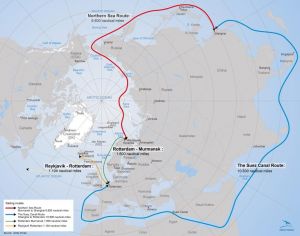Panama and Suez Canal Routes
 Panama and Suez Canal (Map: Arctic Portal)Opening of new shipping routes through the Arctic will not mean a closure of existing ones, connecting North Atlantic Ocean with the Far East. The Suez Canal, which is commonly known as the ´Highway to India´.
Panama and Suez Canal (Map: Arctic Portal)Opening of new shipping routes through the Arctic will not mean a closure of existing ones, connecting North Atlantic Ocean with the Far East. The Suez Canal, which is commonly known as the ´Highway to India´.
It stretches from the Port Said in Egypt, through the Mediterranean Sea to the Port of Suez at the Red Sea, connecting Europe and Asia without navigation around Africa. Since middle of the 19th century it has been the most significant track from the Arctic to Asia.
Suez Canal cut down sailing distances between northern and southern hemisphere by over 20% and made it boon for the trade between these regions. International shipping companies and both European and Asian states invested in Suez shipping route so it could become suitable for ships with a draught up to 19m, which is still sufficient for large container ships sailing from the North Atlantic Ocean down to Asia.
However, with the increasing technology, it will be a near future plan, to make Suez Canal suitable for container ships with a draught up to 21m.
However the Northern Sea Route is much shorter, the importance of Suez Canal is still increasing, making it irreplaceable for cargo ships trading with Far East, India and Southeast Asia.
Opening of Panama Canal in 1914 connected the eastern part of Pacific Ocean with the North Atlantic, establishing important shipping route, between the Pacific coast of America and the Atlantic Routes to Europe and the passage for cargo ships sailing to eastern part of Asia. The canal shortened the route from the North Atlantic to the North Pacific by more than 9000 nautical miles.
The visible importance of Panama Canal in cutting down the sailing distance cannot hide the fact that the Canal is only suitable for ships with the maximum draught of 11m, which is enough for vessels carrying up to 4.500 cargo containers, but still too little for modern long - distance sailing ships.
When in the year 2000 Panama Canal was handled by the UN to the Panama Government future plans for increasing its capacity were decided. However the total cost of building up new locks alongside the existing locks and deepening the channels so the Canal would handle ships carrying up to 5.600 of cargo containers, was estimated for over 7 billion US dollars.
Sources: North Meets North: Navigation and the Future of the Arctic







